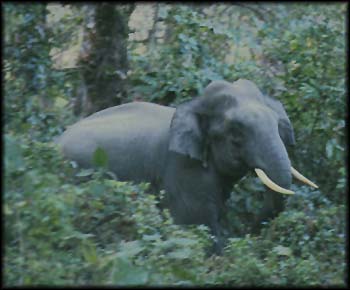| Environment Tuskers in Trouble
|
|||||
Project Elephant never ever got off the ground. Lacking the leadership that Project Tiger was able to benefit from in the person of Kailash Sankhala, Project Elephant has remained a grey initiative, operating within government confines, bound by government limitations. A Parliamentary Standing Committee report points out that the claims made by the Ministry of Environment, that elephant populations had risen from 23,000 in 1989 to 25,000 in 1993, were questionable. The key problem is dwindling habitat and broken migratory corridors. The downlisting of the elephant by CITES at its recently concluded meeting at Harare can only add to the woes of the Indian elephant. On top of all this, the latest threat is an emerging market for elephant meat, particularly in tribal areas. |
Environment • Beautiful Beasts • Paradise in the Wild • The Ocean:Conquest • A Source of Solace • Sighting the Ocean • The Ocean in Verse • Childhood Dream • Hunt for Indian Tiger
Adventure activities | ||||
According to Ajay Desai, a field biologist and a recognised
 expert on elephants: "Kerala, Karnataka and the North-Eastern region are killing fields for elephants." Elephant habitats spread across 11 states in these regions, including Arunachal Pradesh, Meghalaya, Assam, Nagaland, Bihar, Madhya Pradesh, West Bengal, Uttar Pradesh, Orissa, Andhra Pradesh and Tamil Nadu. In every state, development projects now cut across their migratory routes. Canals, roads, mines, dams, and urban complexes are tattering what few forests remain here. Confused, hungry and angry, elephants that used to live in peace with humans have increasingly taken to attacking humans. The problem is particularly severe in Assam, West Bengal and the Andhra Pradesh-Tamil Nadu border. The 'solution' being put forward is to capture elephants and 'put them to use'. This is a euphemism for condemning them to a life of slavery, most often hauling timber or helping in the construction of roads which will further degrade their own homes. expert on elephants: "Kerala, Karnataka and the North-Eastern region are killing fields for elephants." Elephant habitats spread across 11 states in these regions, including Arunachal Pradesh, Meghalaya, Assam, Nagaland, Bihar, Madhya Pradesh, West Bengal, Uttar Pradesh, Orissa, Andhra Pradesh and Tamil Nadu. In every state, development projects now cut across their migratory routes. Canals, roads, mines, dams, and urban complexes are tattering what few forests remain here. Confused, hungry and angry, elephants that used to live in peace with humans have increasingly taken to attacking humans. The problem is particularly severe in Assam, West Bengal and the Andhra Pradesh-Tamil Nadu border. The 'solution' being put forward is to capture elephants and 'put them to use'. This is a euphemism for condemning them to a life of slavery, most often hauling timber or helping in the construction of roads which will further degrade their own homes.
In this ocean of misery, there are some signs that the efforts of sincere officers and scientists may actually work out. One such is the effort to create an elephant corridor between Idukki and Parambikulam. Here around 60 acres of land has been set-aside for protection and greening. Guards, wireless stations and a general 'hands-off' policy may well restore this one track to the gentle giants. As if the problems faced by elephants were not already bad enough, the West Bengal Government has plans to build a major project involving the wildlife rich Sankosh river environs. The project seeks to augment the flow of water through the Farakka Barrage, reduced as a result of the water-sharing pact with Bangladesh. Soon after the pact had been signed the Chief Minister of West Bengal, Mr. Jyoti Basu, stated at a press conference that the deal would not affect the Calcutta Port as 12,000 cusecs of water would be diverted thanks to the Sankosh project through Farakka. However, the Union Environment Ministry has raised very valid objections to the scheme, which involves the linking of the Sankosh river in Bhutan to the Teesta through a 43-km feeder canal. This will seriously threaten three sanctuaries and until the alignment is changed, a threat will hang over the future of the Buxa Tiger Reserve, the Jaldapara Rhino Sanctuary and the Garuma Reserve Forests. The truth is that the Sankosh project concerns hydrology less than it does politics. The Ministry of External Affairs is pursuing the Sankosh project with enthusiasm and officers are camped in Bhutan to negotiate its concurrence for the Rs. 7,000 crore multipurpose river project, ignoring the fact that tigers, elephants, rhinos and gaur are among the animals that will be affected. There is every chance that the Sankosh project might obtain the necessary sanctions bypassing objections from environmentalists and hydrologists. Wildlifers anxiously await the outcome of yet another barrage on natural India.
Courtesy: Sanctuary Magazine
|
|||||
Editor: Romola Butalia (c) India Travelogue. All rights reserved. |
|||||
